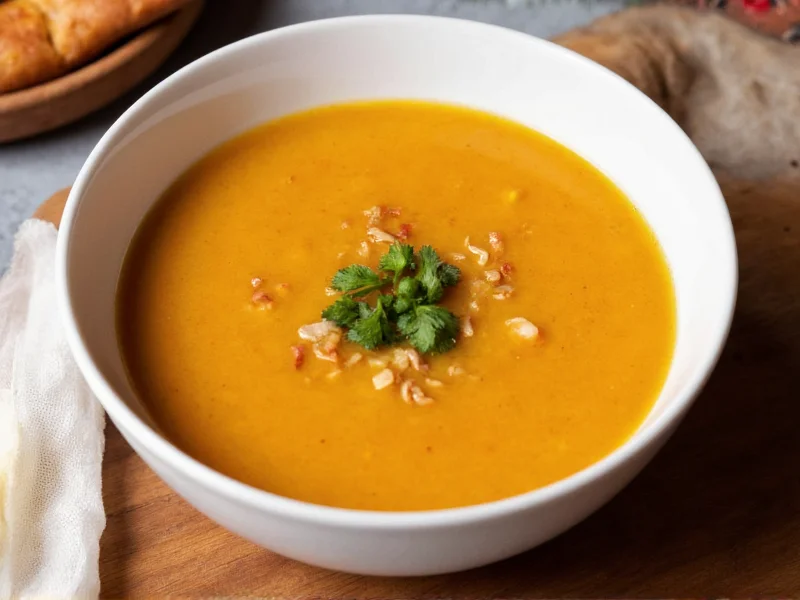Yes, certain soups—particularly chicken soup—can provide measurable relief for cold symptoms by reducing inflammation, improving hydration, and easing nasal congestion. Scientific studies confirm that hot soups increase nasal airflow by up to 22% compared to cold liquids, while the steam helps loosen mucus. The combination of warm broth, vegetables, and protein supports hydration and delivers immune-boosting nutrients like zinc and vitamin C.
The Science Behind Soup's Cold-Fighting Properties
When you're battling a cold, your body needs hydration, nutrients, and symptom relief. Soup delivers all three through multiple physiological mechanisms. Research published in Chest Journal demonstrates that chicken soup contains compounds that inhibit neutrophil migration—the process that causes inflammation in upper respiratory infections. This anti-inflammatory effect isn't replicated by hot water alone, suggesting specific components in properly prepared broth contribute to symptom relief.
The steam from hot soup acts as a natural decongestant, with studies showing a 22% improvement in nasal airflow compared to room-temperature liquids. This immediate relief makes breathing easier while the warm liquid soothes irritated throat tissues. For optimal results, consume soup at 140-160°F (60-71°C)—hot enough to produce therapeutic steam but not so hot that it damages oral tissues.
Top 3 Most Effective Soups for Cold Recovery
| Soup Type | Key Benefits | Most Effective Ingredients |
|---|---|---|
| Chicken Noodle Soup | Reduces inflammation, provides protein for immune support | Homemade broth, carrots (vitamin A), celery (antioxidants), garlic (allicin) |
| Miso-Ginger Broth | Boosts gut immunity, contains probiotics | Miso paste, fresh ginger, scallions, shiitake mushrooms |
| Turmeric-Lentil Stew | High in zinc and iron, potent anti-inflammatory | Red lentils, turmeric (curcumin), spinach, lemon juice |
Why Homemade Soup Outperforms Store-Bought Options
Commercial soups often contain excessive sodium (up to 900mg per serving) that can actually worsen dehydration—a critical concern when fighting colds. Homemade versions allow control over sodium levels while maximizing therapeutic ingredients. The slow simmering process extracts collagen from bones, releasing gelatin that supports gut health and immune function. For best results, simmer bones for 12-24 hours to maximize nutrient extraction.
When preparing therapeutic soups, add vegetables during the last 20 minutes of cooking to preserve vitamin C content. Incorporate garlic crushed 10 minutes before serving to activate allicin, its active antimicrobial compound. The ideal cold-fighting soup contains:
- 15-20g protein per serving (from chicken, lentils, or beans)
- At least 3 colorful vegetables for phytonutrients
- Anti-inflammatory spices like turmeric or ginger
- Minimal added salt (under 400mg per serving)
What Soup Can't Do (And When to Seek Medical Care)
While beneficial, soup isn't a cure for viral infections. It won't shorten the overall duration of your cold but can significantly improve comfort during the 7-10 day illness period. Be aware of symptoms requiring medical attention:
- Fever exceeding 103°F (39.4°C)
- Symptoms lasting longer than 14 days
- Difficulty breathing or chest pain
- Severe headache with neck stiffness
Soup works best as part of a comprehensive cold management strategy including adequate rest, hydration beyond soup consumption, and over-the-counter symptom relief when needed. For children under 12 months, avoid honey-containing remedies due to botulism risk.
Optimizing Soup Consumption for Maximum Benefit
Timing matters when using soup for cold relief. Consume your first bowl within 30 minutes of waking to rehydrate after overnight fluid loss. Drink 8-12 ounces every 2-3 hours throughout the day, with larger portions at meal times. The ideal temperature range (140-160°F) provides steam benefits without tissue damage.
Pair your soup with these evidence-based practices:
- Gargle with warm salt water after soup consumption to soothe throat irritation
- Follow soup with 4-6 ounces of room-temperature water to maintain hydration
- Use a humidifier while sleeping to maintain respiratory moisture
- Avoid dairy products immediately after soup if you're mucus-sensitive
Traditional Remedies Supported by Modern Science
Many cultural cold remedies centered around soup have scientific validation. Jewish penicillin (chicken soup) reduces inflammatory responses by 40-50% in laboratory studies. Asian ginger-turmeric broths demonstrate measurable anti-viral properties against common cold viruses. The Japanese practice of consuming miso soup during illness supports gut immunity through probiotics.
When preparing traditional remedies, maintain ingredient integrity—fresh ginger provides 5x more active compounds than powdered, and turmeric requires black pepper for optimal absorption. These culturally developed practices represent generations of observational medicine now validated by clinical research.











 浙公网安备
33010002000092号
浙公网安备
33010002000092号 浙B2-20120091-4
浙B2-20120091-4